The Economics and Statistics Division maintains archives of previous publications for accountability purposes, but makes no updates to keep these documents current with the latest data revisions from Statistics Canada. As a result, information in older documents may not be accurate. Please exercise caution when referring to older documents. For the latest information and historical data, please contact the individual listed to the right.
<--- Return to Archive
For additional information relating to this article, please contact:
June 24, 2024STATISTICS CANADA POPULATION PROJECTIONS, 2023-2048 Statistics Canada has revised and updated its population projections. Projections for provincial population are available through 2048.
Statistics Canada's population projections are based on different assumptions about: fertility, life expectancy, immigration, emigration, non-permanent residents and interprovincial migration. These assumptions are combined into low, medium and high growth scenarios as well as slow- and fast-aging scenarios.
Medium scenarios are further divided by assumptions for interprovincial migration. The M1 medium growth scenario, along with low-growth, high-growth, slow-aging and fast-aging scenarios assume that recent interprovincial migration trends transition to a long-run average (1991-2023). Other medium growth scenarios assume interprovincial migration follows patterns from different eras in recent history: 1995-2011 (M2), 2003-2009 (M3), 2009-2017 (M4), 2014-2017 (M5) and 2020-2023 (M6).
Under all scenarios, Nova Scotia's population is projected to be larger in 2048 than it was in 2023 (1.06 million). Nova Scotia's population in 2048 under Statistics Canada's scenarios ranges from 1.11 million (M3) to 1.49 million (M6).
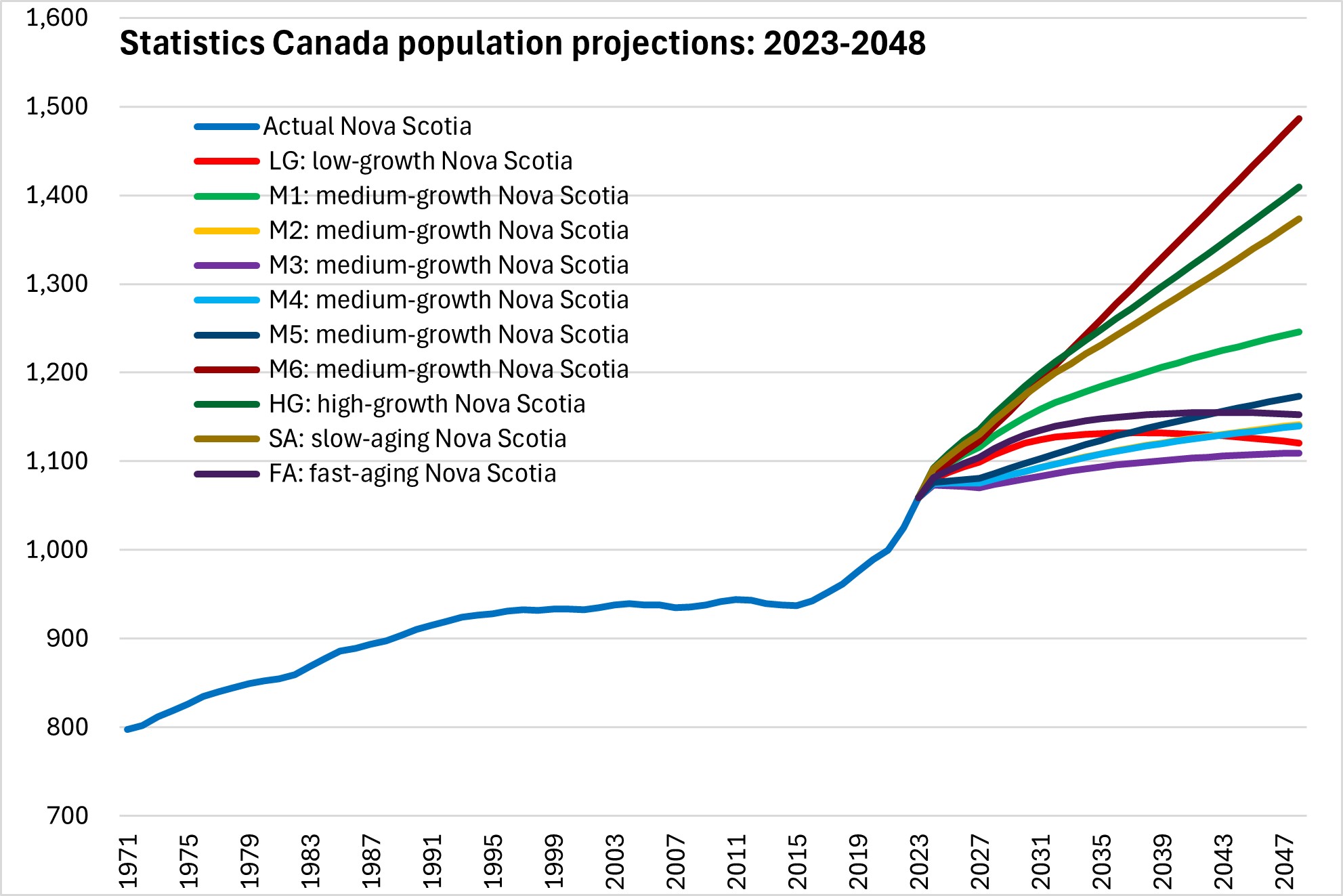
Statistics Canada's population projections for Nova Scotia are highly sensitive to assumptions about interprovincial migration. While some Statistics Canada scenarios assume interprovincial migration reverts to trends observed during the commodity price and investment booms of earlier decades (a net loss of over 2,000), others assume that recent interprovincial migration trends persist and deepen (with net gains in excess of 12,000 per year). This generates a wide range of possible population growth rates for Nova Scotia.
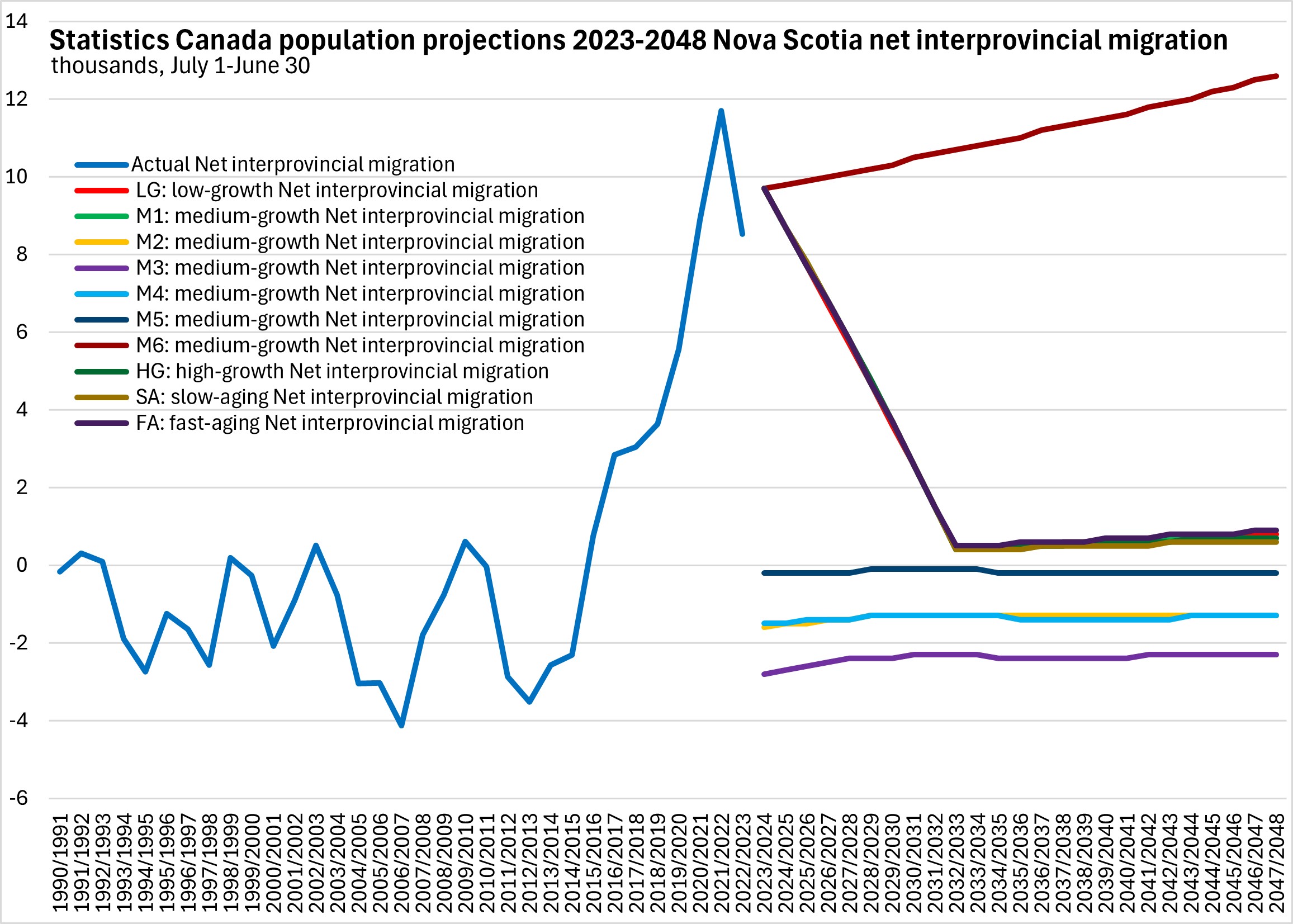
In recent years, net changes in non-permanent residents (such as those with work permits or study permits) have been a significant source of population growth in Nova Scotia. All of Statistics Canada's population projection scenarios assume that there will be a reversal in the number of non-permanent residents in Nova Scotia in the next three years. By 2048, all of Statistics Canada's assumptions about net change in non-permanent residents in Nova Scotia fall in a range from -200 to +800 per year.
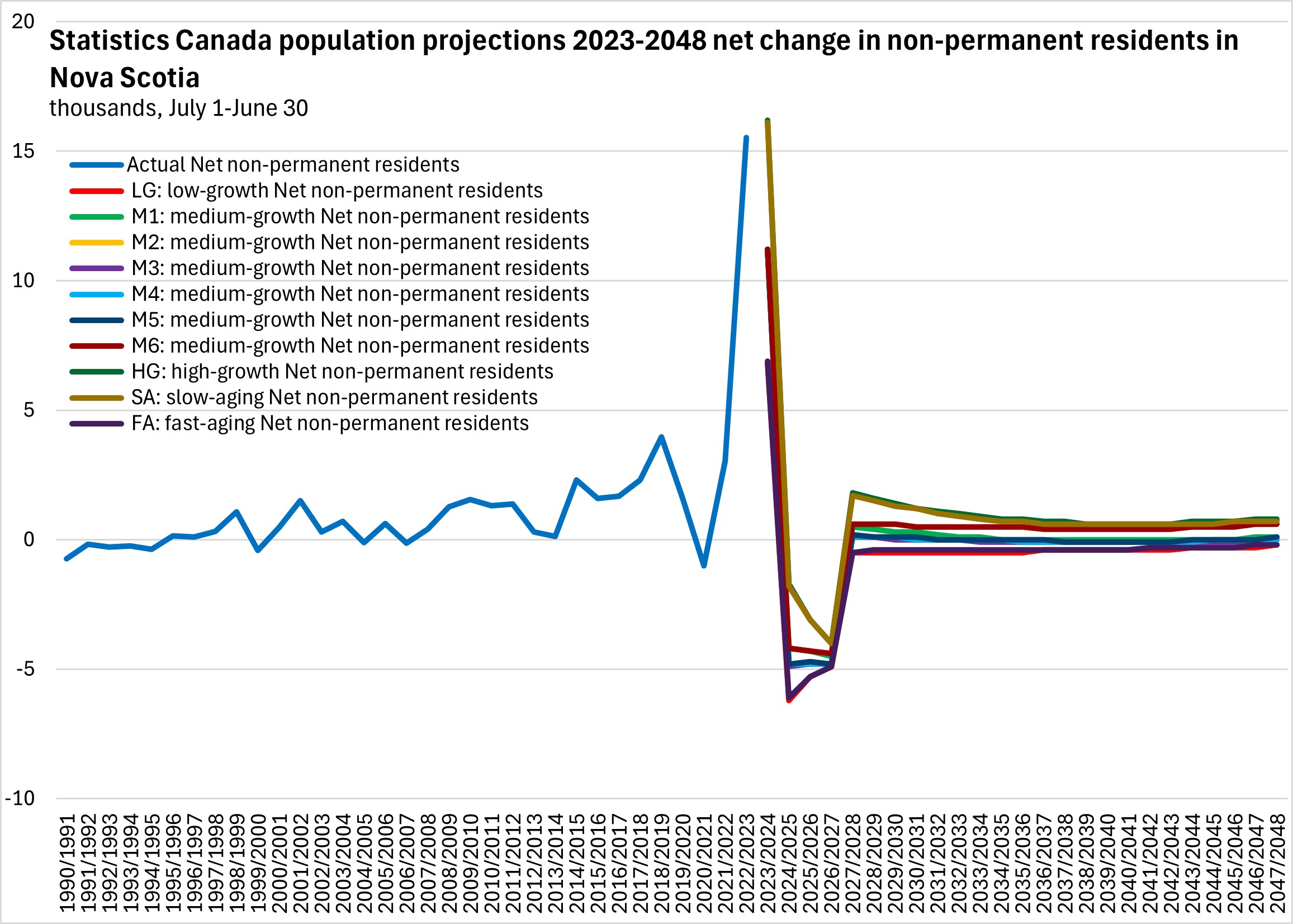
Immigration has also been an important source of population growth in Nova Scotia since 2015. Statistics Canada's projection scenarios all assume Nova Scotia's immigration declines after extraordinary levels in the last two years. Some of Statistics Canada's scenarios assume that immigration rises steadily thereafter, reaching 13,000-14,000 per year. Even in Statistics Canada's lowest immigration assumptions for Nova Scotia, immigration levels are consistent with levels observed in 2018-2019 (over 6,000 per year).
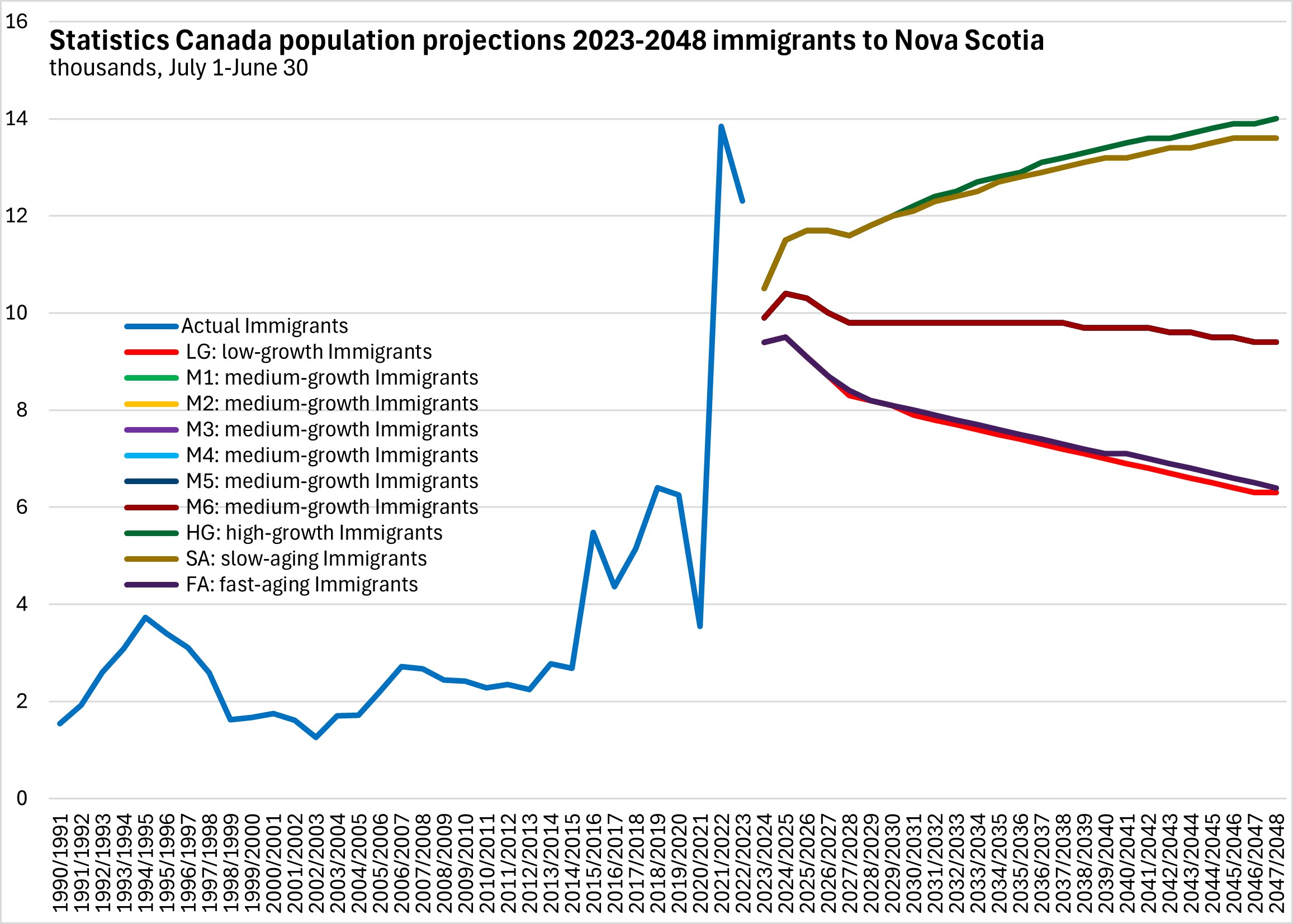
Statistics Canada's net emigration scenarios all assume slow increases in net emigration from Nova Scotia in the next 25 years. Emigration to other countries is projected to be only a small population drain on Nova Scotia under all of Statistics Canada's population scenarios.

Apart from immigration and interprovincial migration, Statistics Canada's assumptions about fertility rates and births lead to the next largest ranges of population growth across the scenarios. Two scenarios assume continue decline in births to 7,000 per year by 2048 while others assume births rise to over 12,000 per year by 2048.
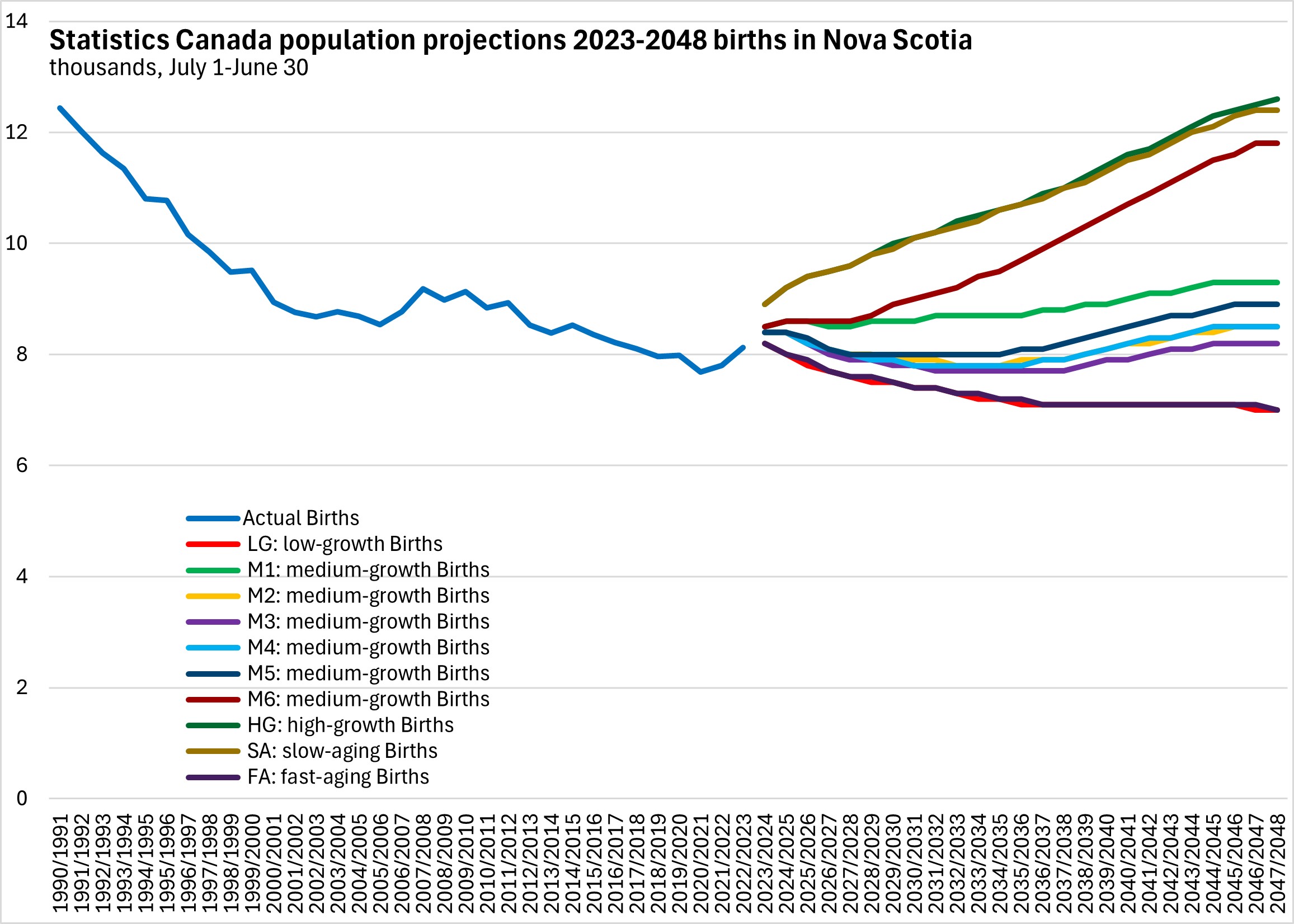
All of Statistics Canada's population projection scenarios assume rising deaths in Nova Scotia. By 2048, the number of deaths under Statistics Canada's scenarios are projected to range from 14,100 to 16,000.
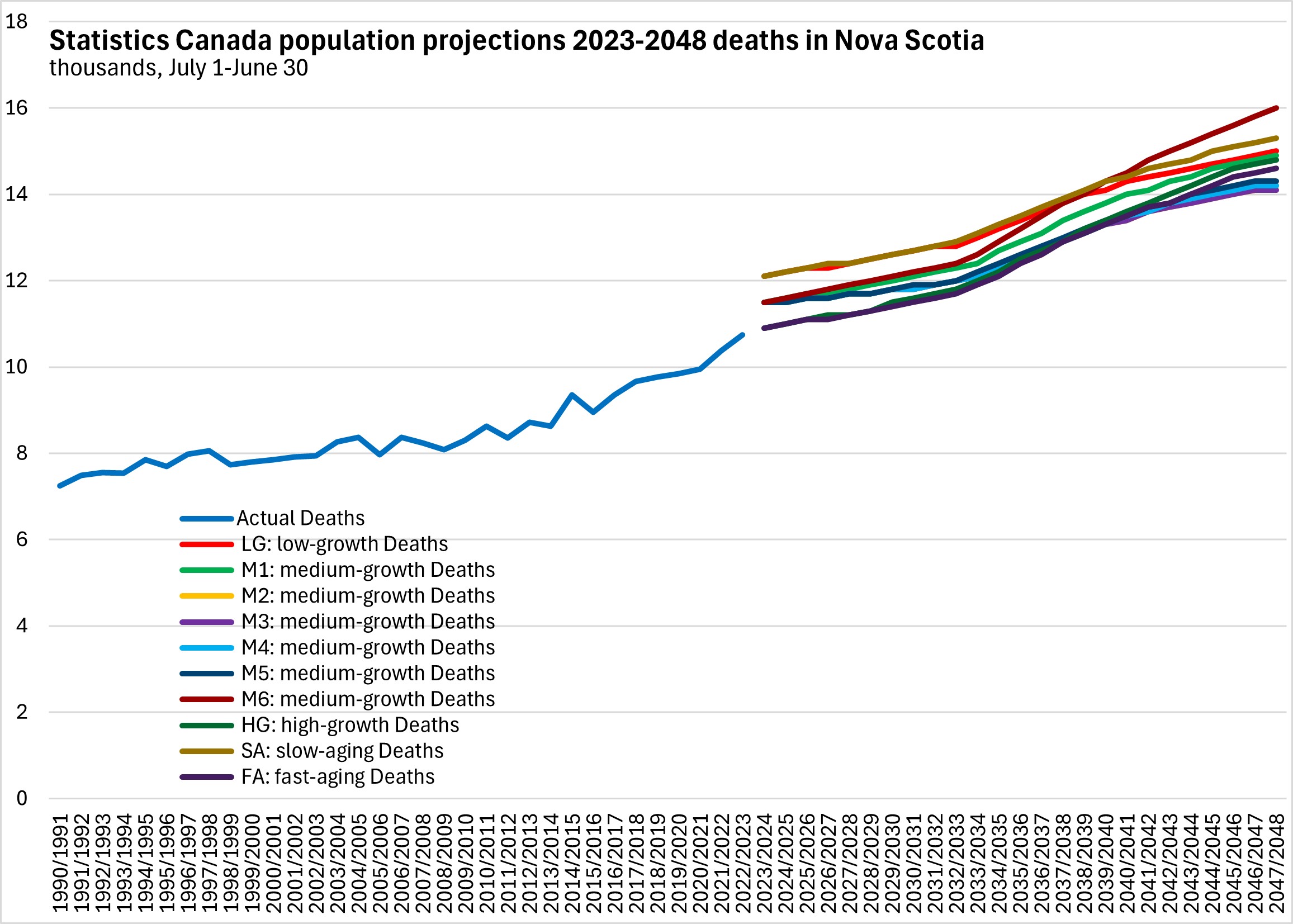
Under Statistics Canada's low growth scenario, Nova Scotia's population is projected to grow faster than the national average in the next 5 years as high net interprovincial gains persist in the near term. However, population growth is projected to moderate in the 2030s and by the 2040s. Despite modest interprovincial population gains, Statistics Canada's low growth scenario projects a declining population for Nova Scotia (as well as for Newfoundland and Labrador, New Brunswick and Québec). By 2048, Statistics Canada's low-growth projection assumes that the population of Nova Scotia will be 5.86% larger than it was in 2023.
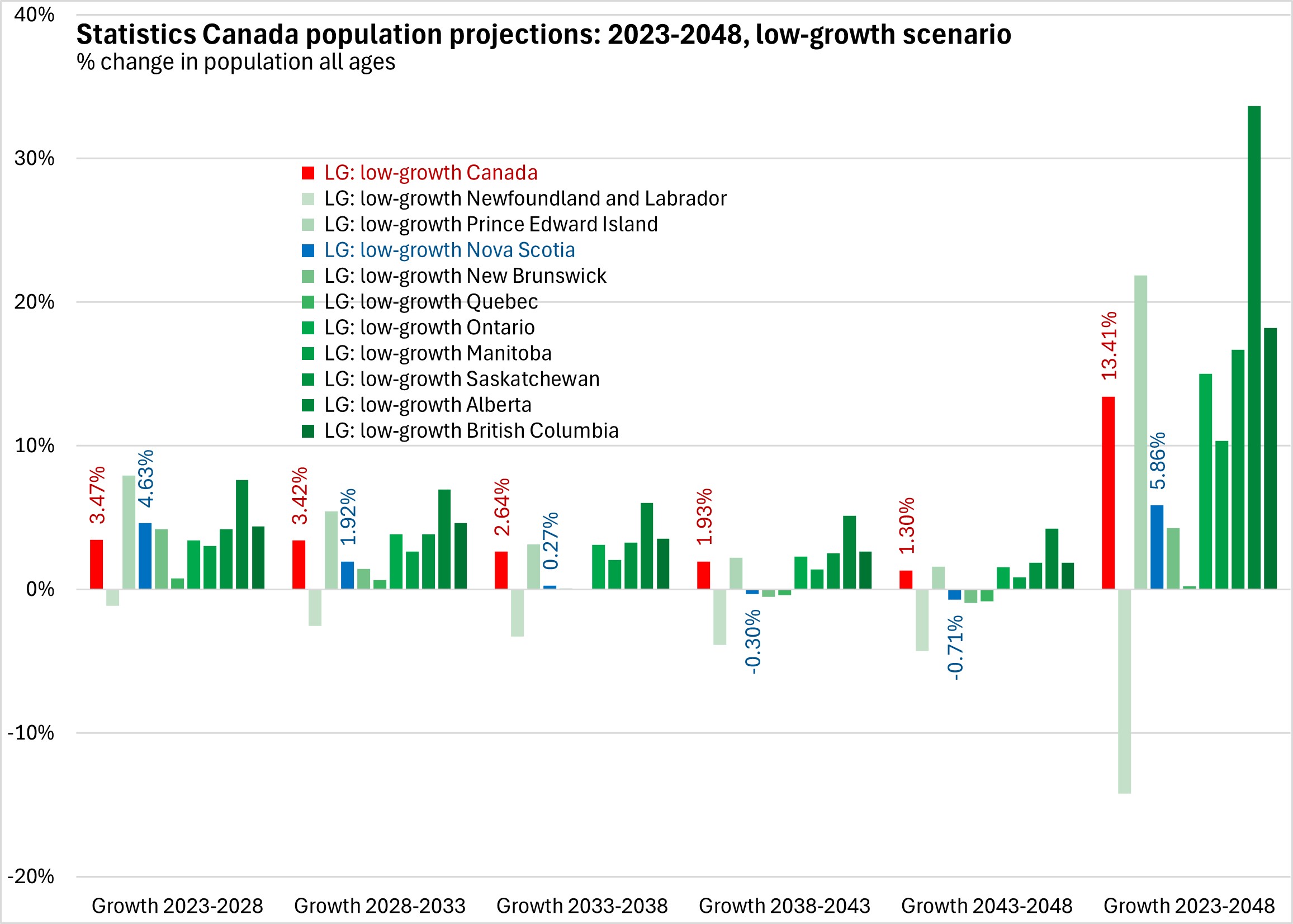
In Statistics Canada's M1 medium growth scenario, Nova Scotia's population is projected to continue growing, rising by 17.7% from 2023-2048. Growth is driven by small gains from interprovincial migration as well as a higher number of births and immigrants than under Statistics Canada's low growth scenario.
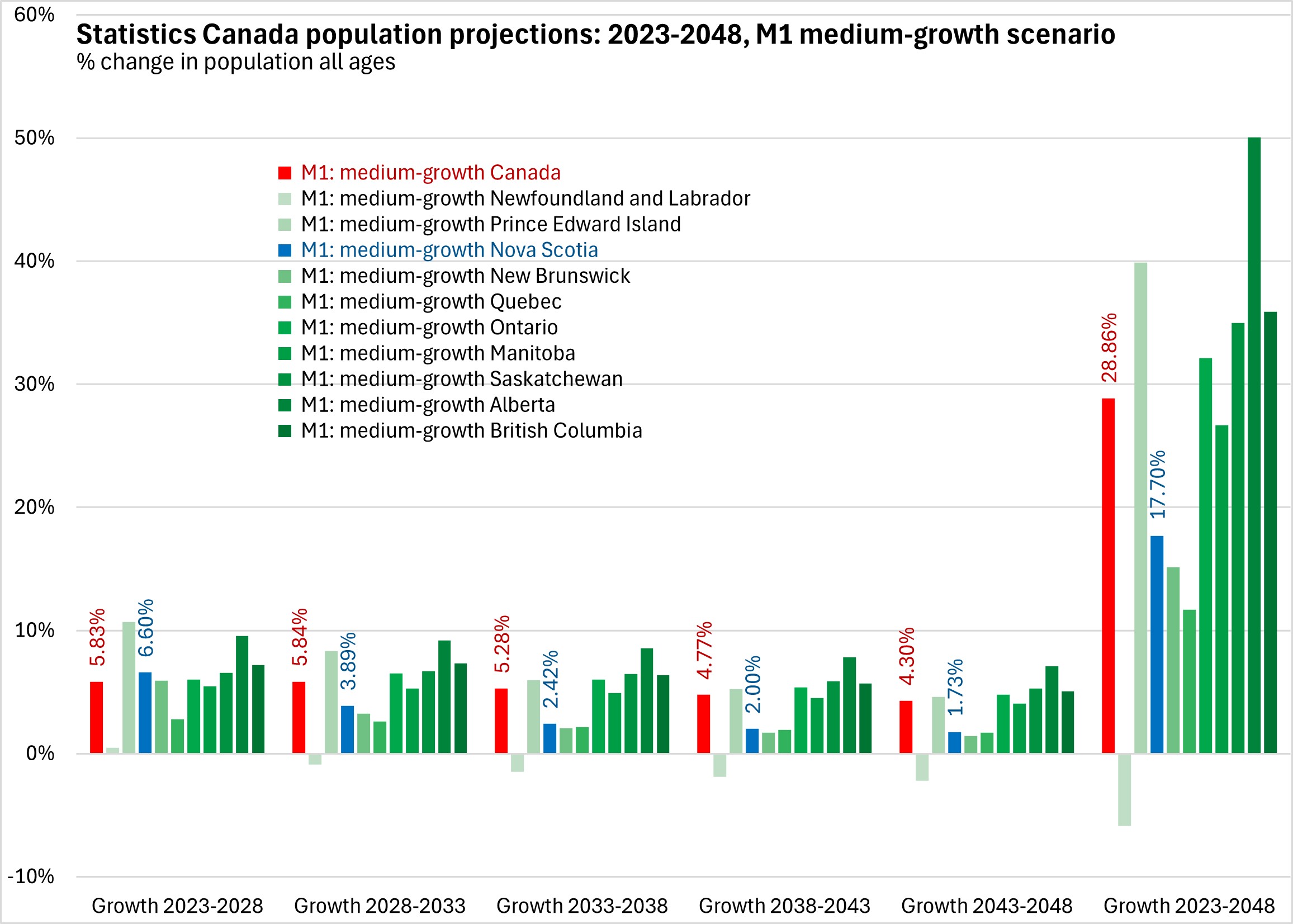
Under Statistics Canada's M2 population scenario, Nova Scotia's population growth is projected to decelerate rapidly in the near term. Steady but slower growth in coming decades would leave Nova Scotia's population 7.8% larger in 2048 than in 2023 in Statistics Canada's M2 population scenario.
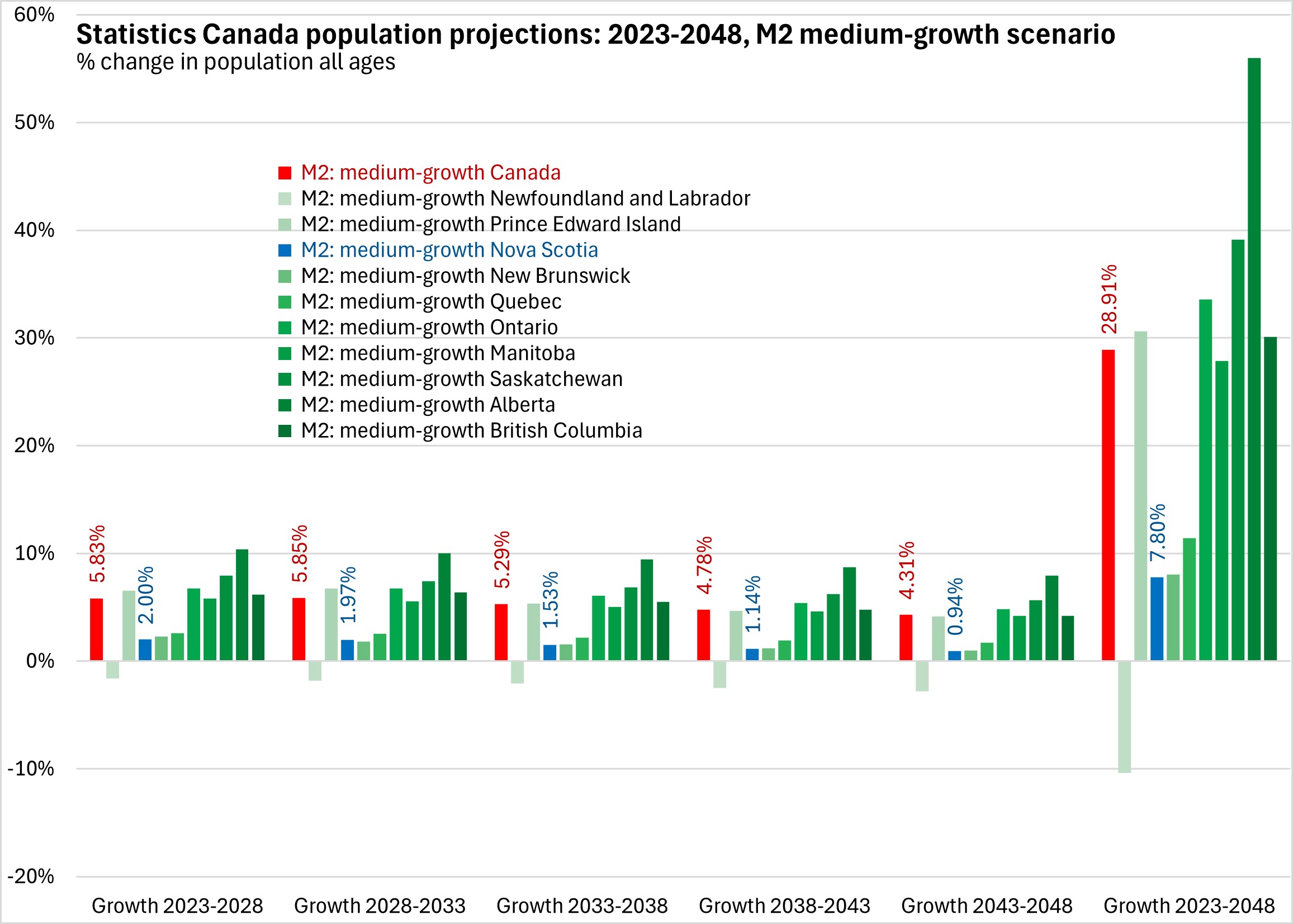
Statistics Canada's M3 scenario features the largest net interprovincial population drain from Nova Scotia by 2048, slowing population growth to just 4.81% by 2048.
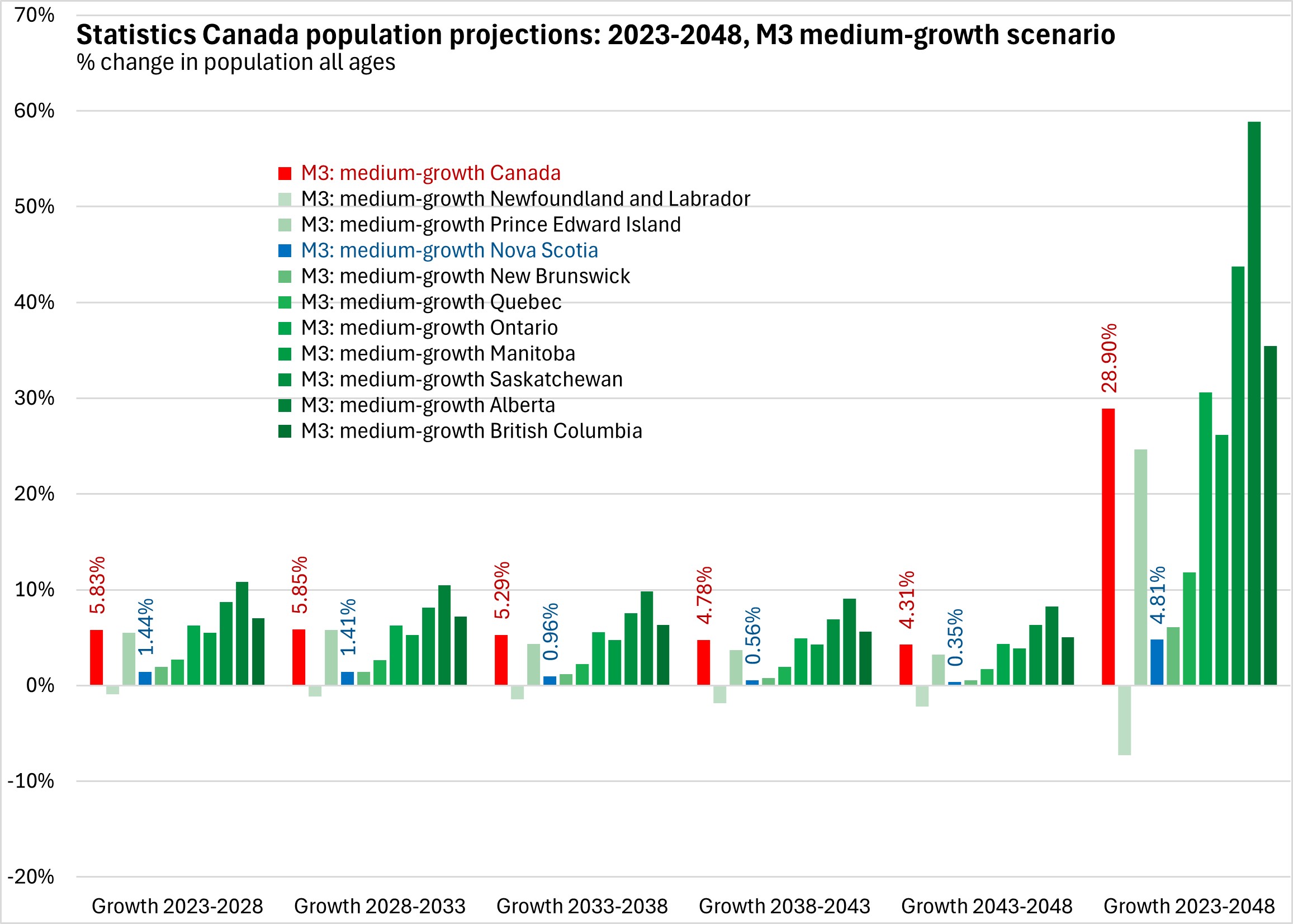
Statistics Canada's M4 population scenario for Nova Scotia features very similar growth rates and assumptions as found in the M2 scenario.
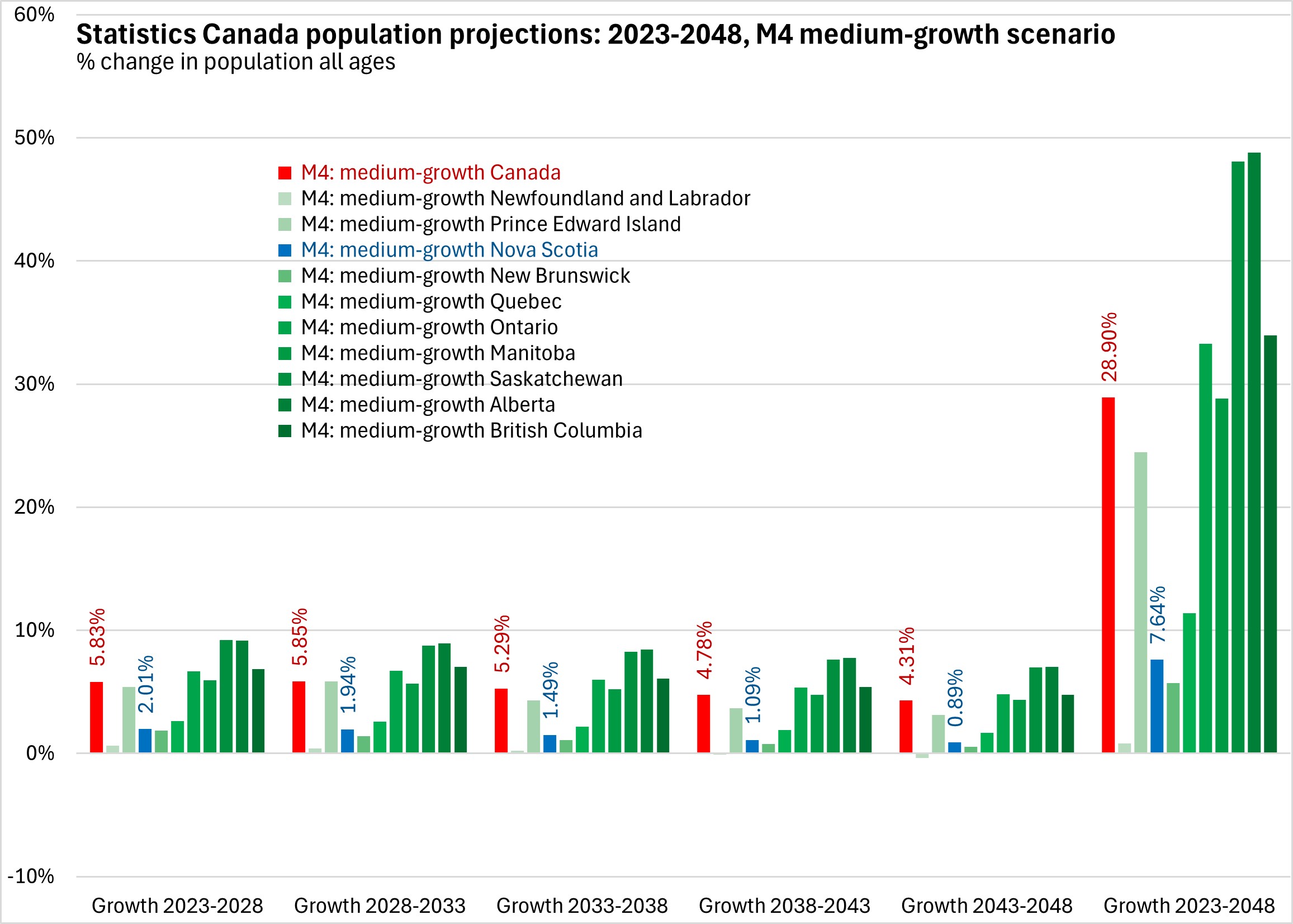
Under Statistics Canada's M5 scenario, net interprovincial migration remains roughly balanced (as do non-permanent resident flows), with little impact on overall population levels. Births and immigration contribute to population growth of 10.84% for Nova Scotia over 2023-2048 in Statistics Canada's M5 scenario.
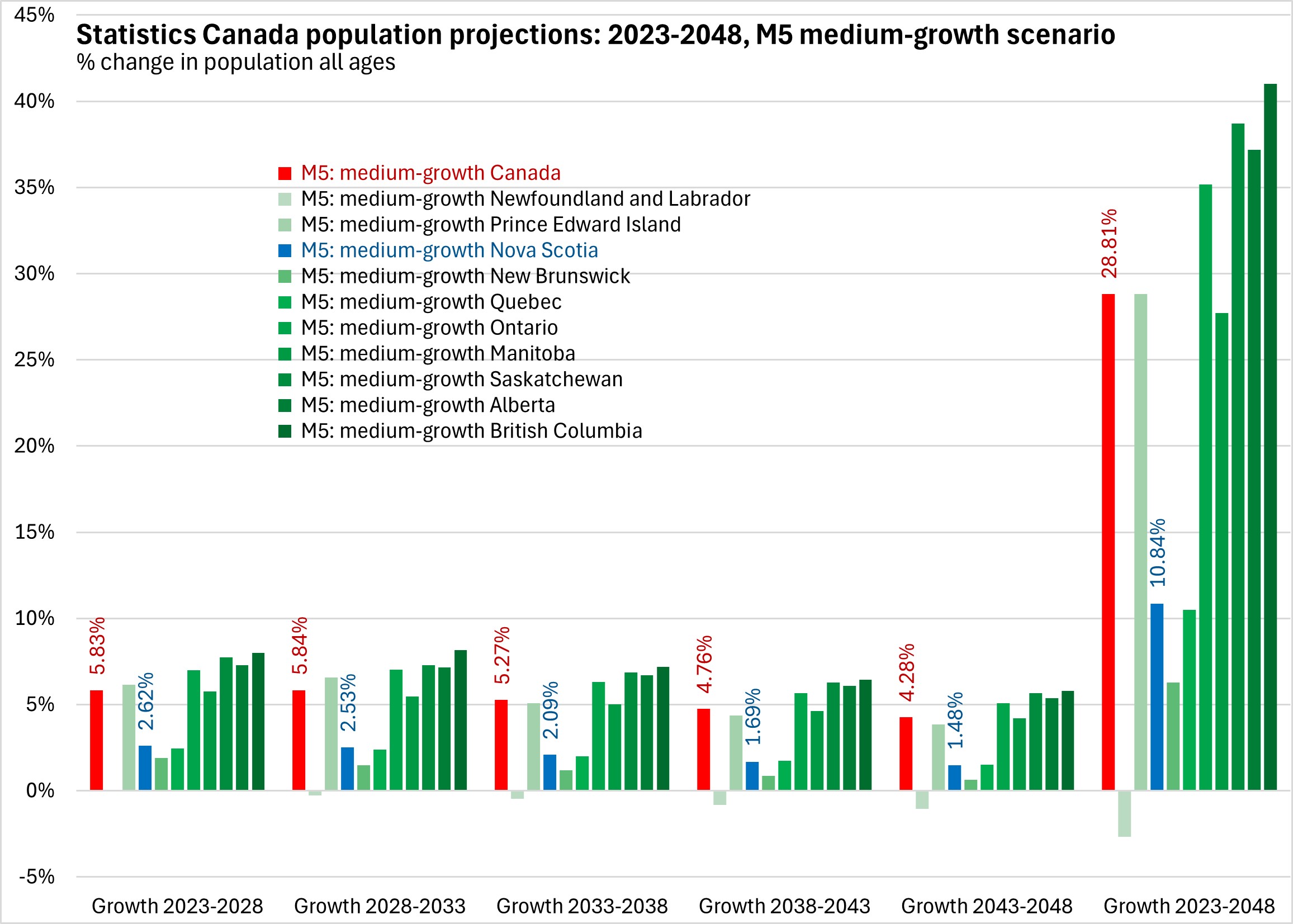
In the M6 population scenario, Statistics Canada assumes that Nova Scotia's recent strength in interprovincial migration gains resumes after a brief correction. In this scenario, Statistics Canada assumes steady and strong population growth for Nova Scotia throughout the next 25 years, amounting to a 40.42% rise from 2023 to 2048, outpacing national population growth (28.86%).
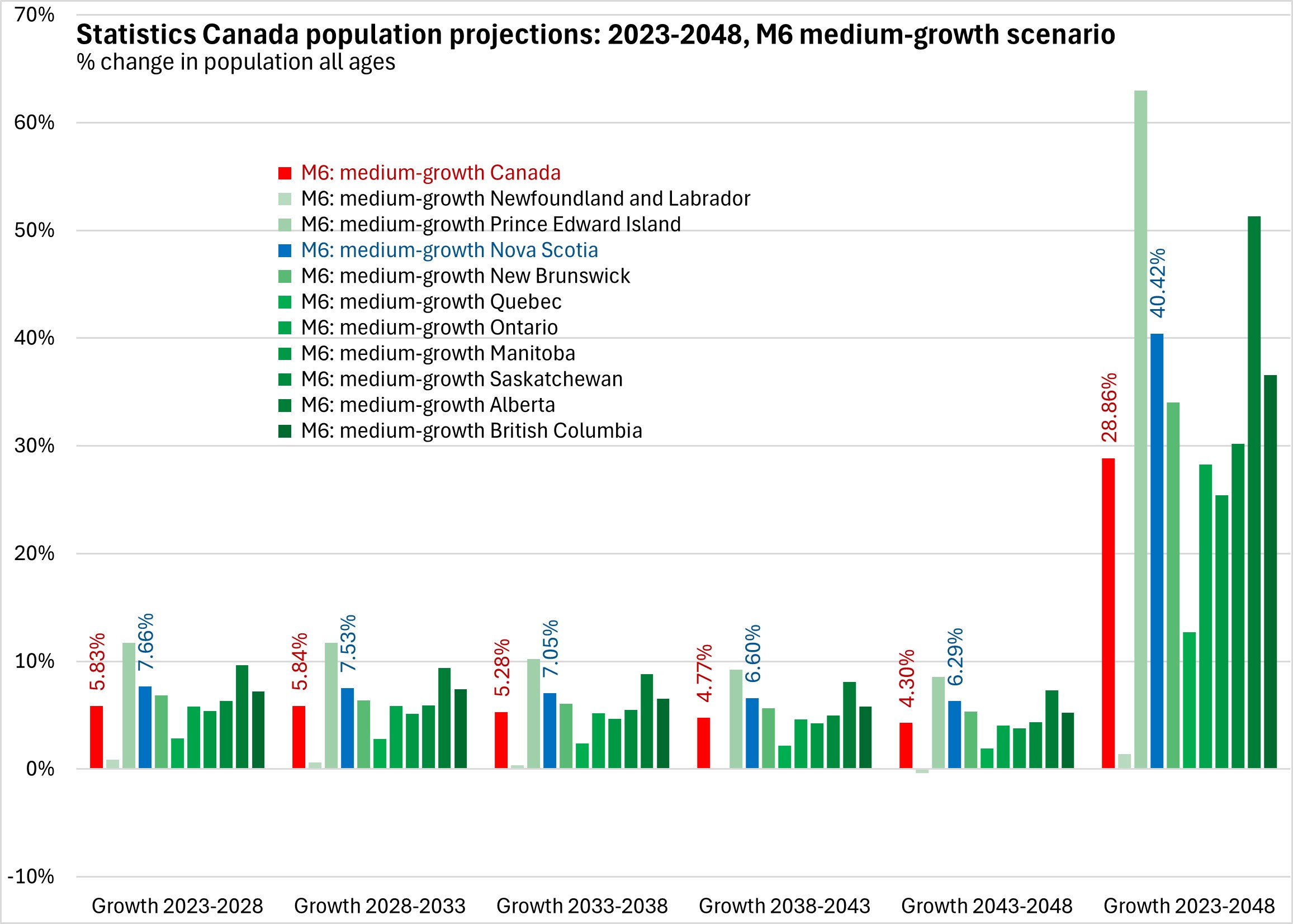
Statistics Canada's assumptions for high growth (more immigration, higher fertility) do not have as much of an impact on Nova Scotia's population growth as the assumption about sustained trends in interprovincial migration gain assumed in scenario M6. Under Statistics Canada's high growth scenario, small interprovincial population gains limit Nova Scotia's population growth to 33.12% from 2023-2048 while the national population grows by 49.28%.
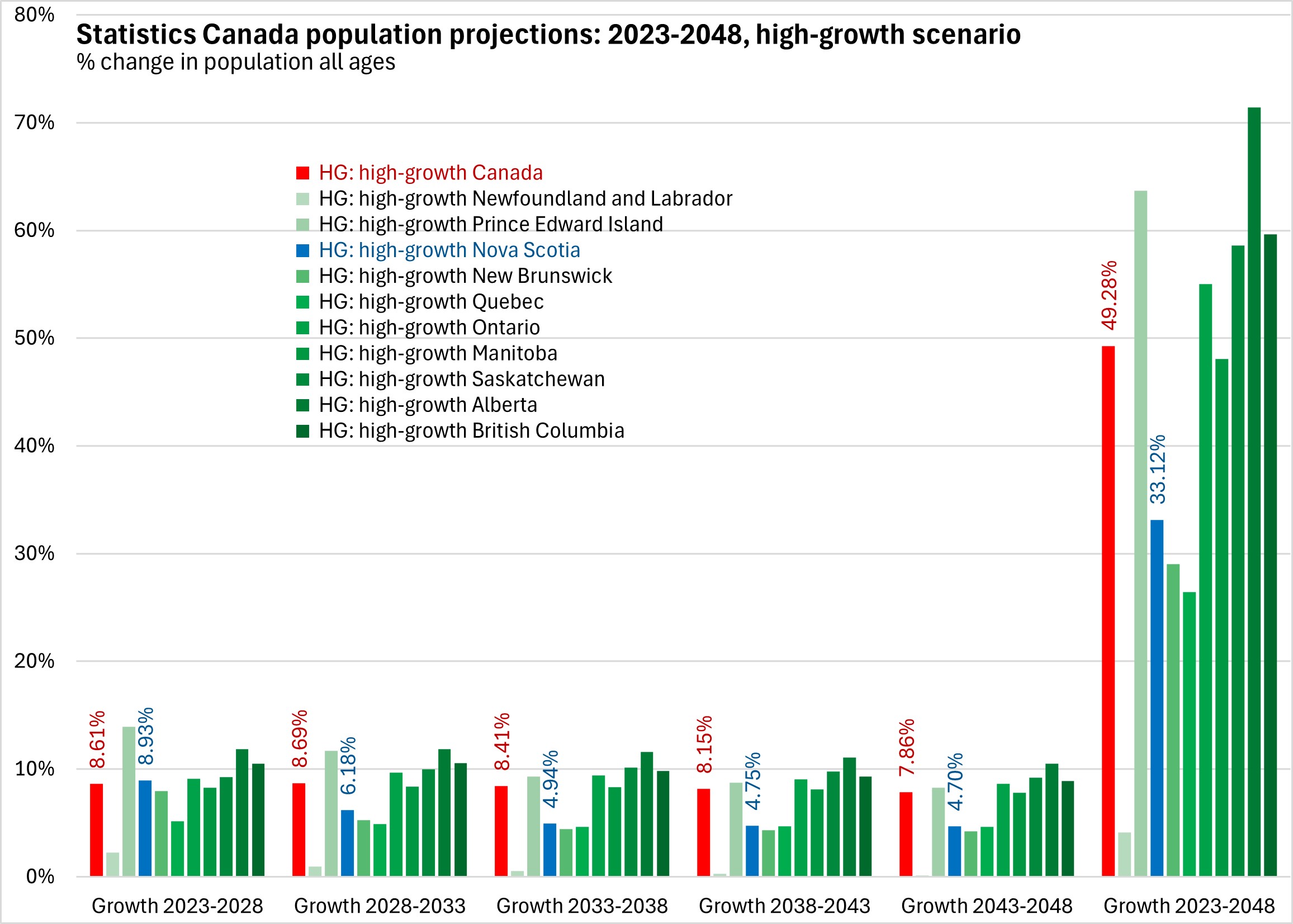
For Nova Scotia, the assumptions of Statistics Canada's slow-aging scenario generate similar (though slightly slower) population increases compared to the high-growth scenario.
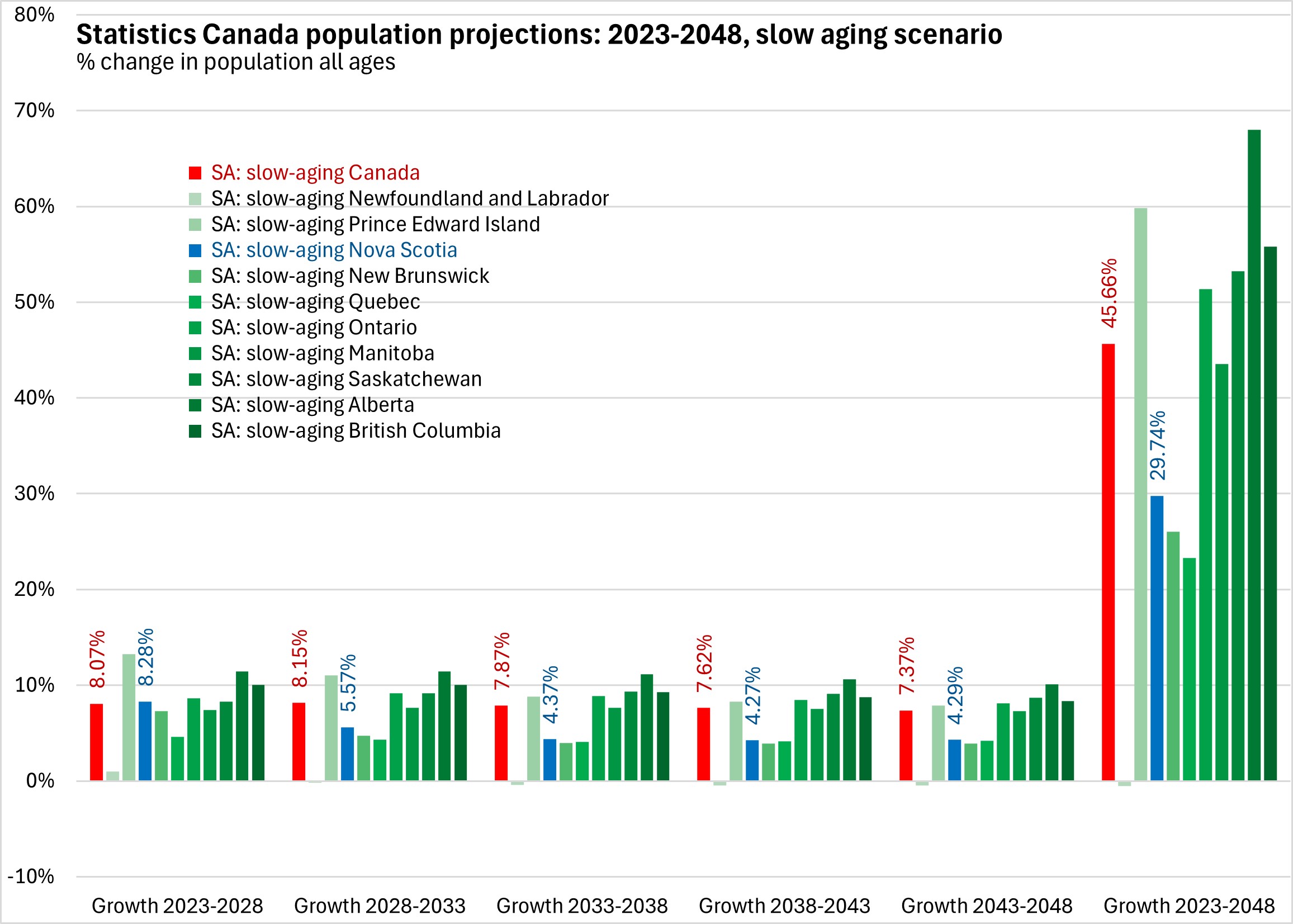
In Statistics Canada's fast-aging scenario, Nova Scotia's population growth is constrained by low births and limited immigration. This results in population declines in the 2040s and an overall population gain of 8.87% from 2023-2048.
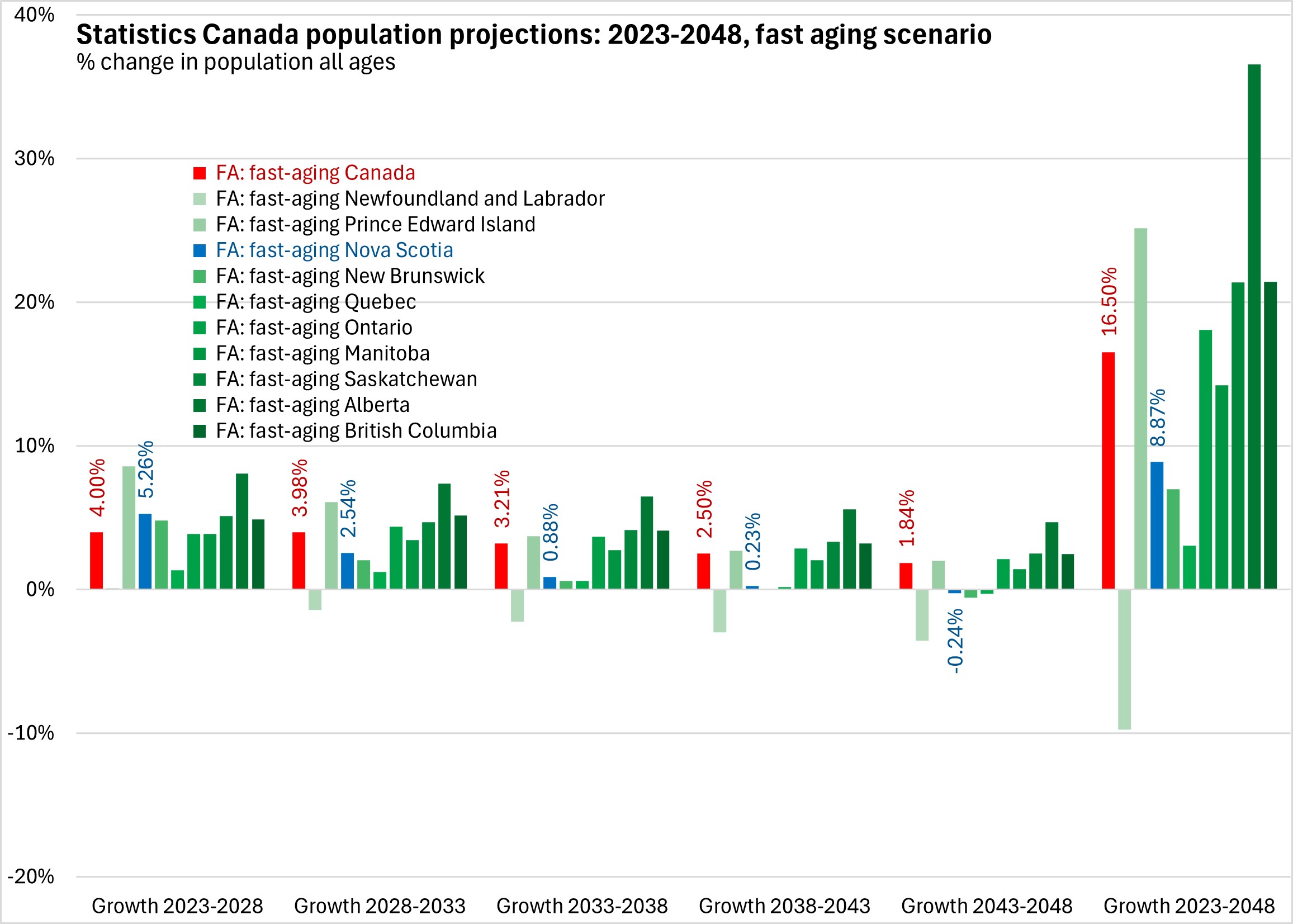
Under most of Statistics Canada's population projection scenarios, growth is faster in Prince Edward Island, Ontario and Western Canada and slower in Québec, New Brunswick and Nova Scotia. In 7 of 10 scenarios, Statistics Canada projects population declines in Newfoundland and Labrador by 2048. Many of these projections hinge on the assumption that interprovincial migration patterns will return to what was observed in the past.
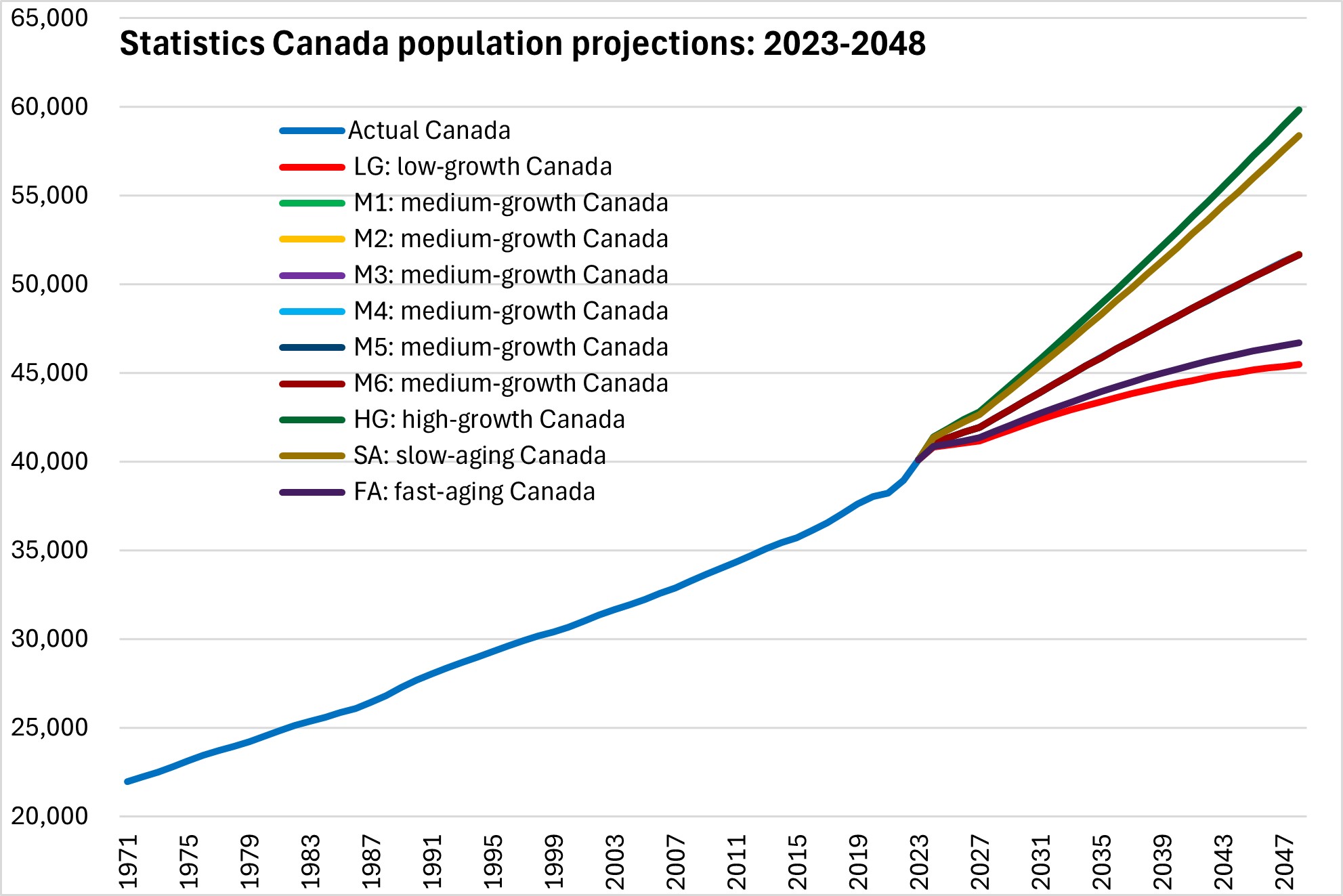
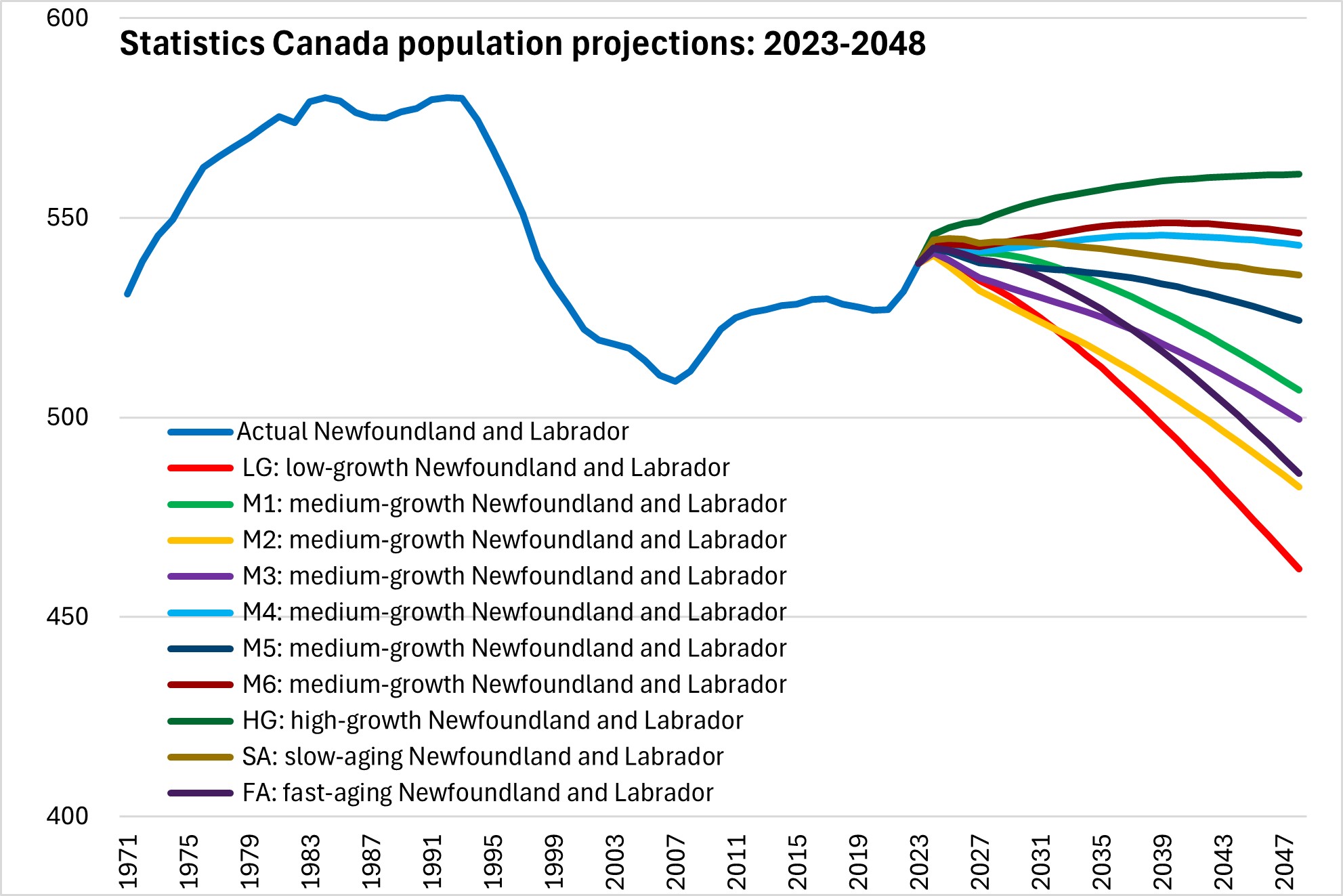
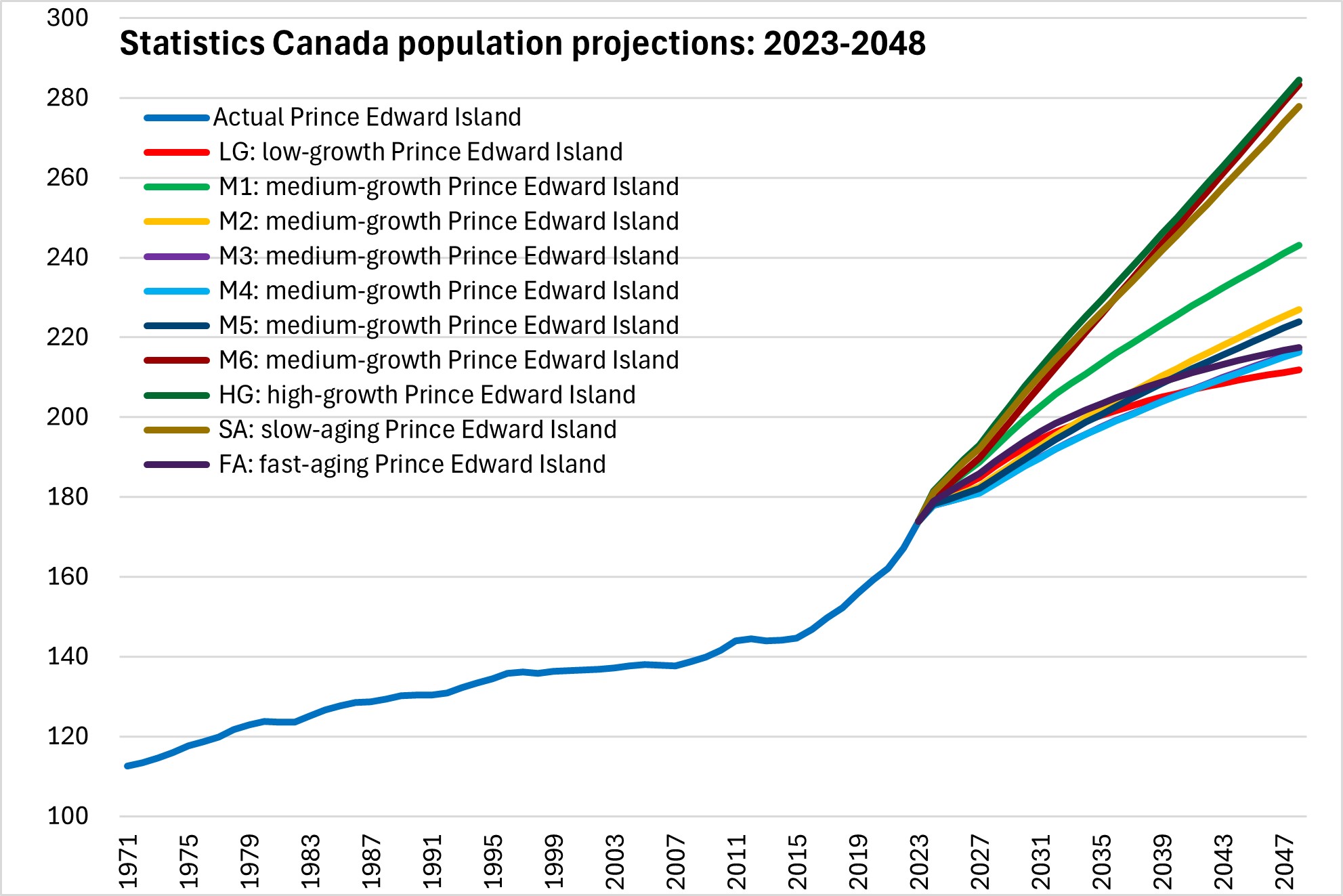
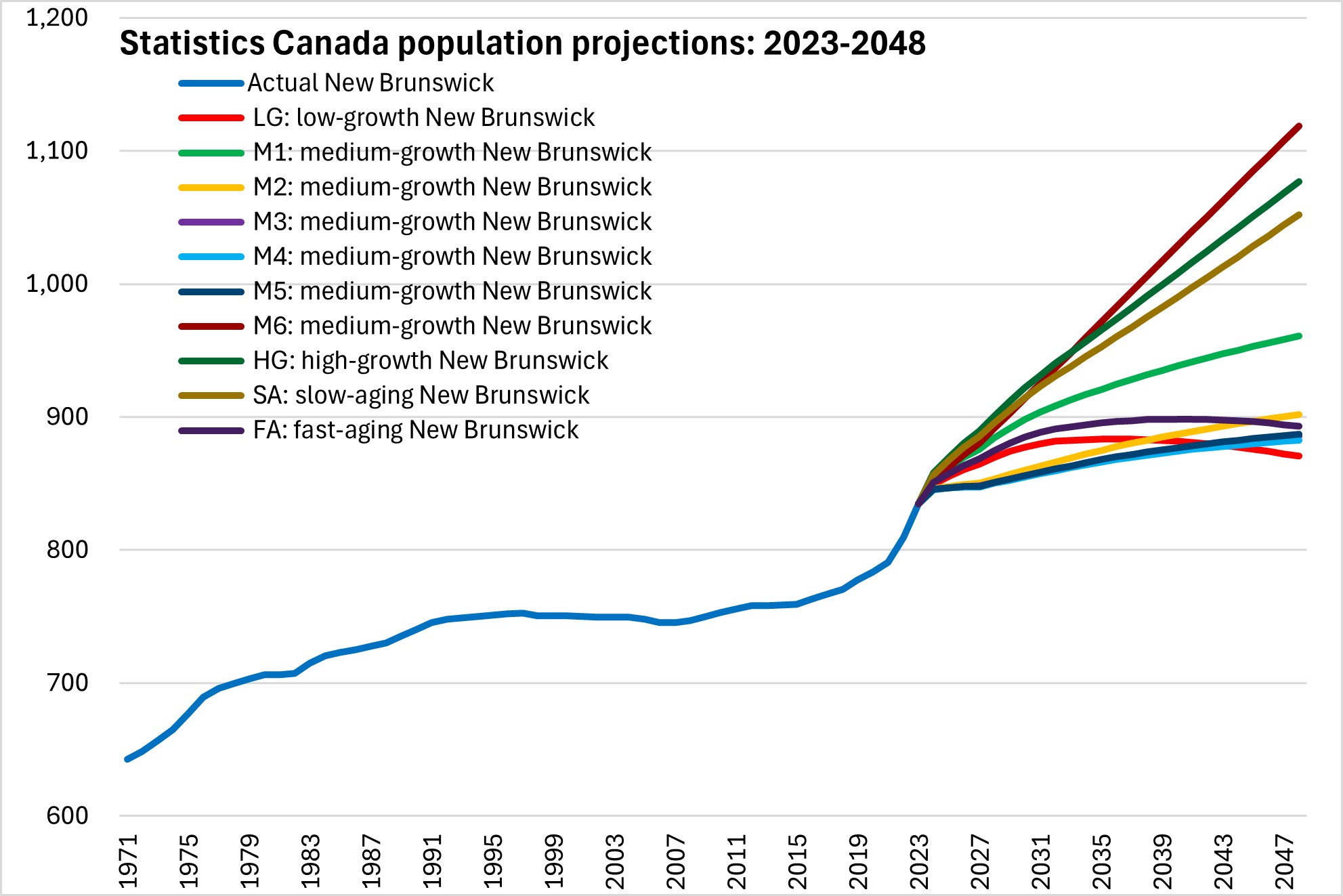
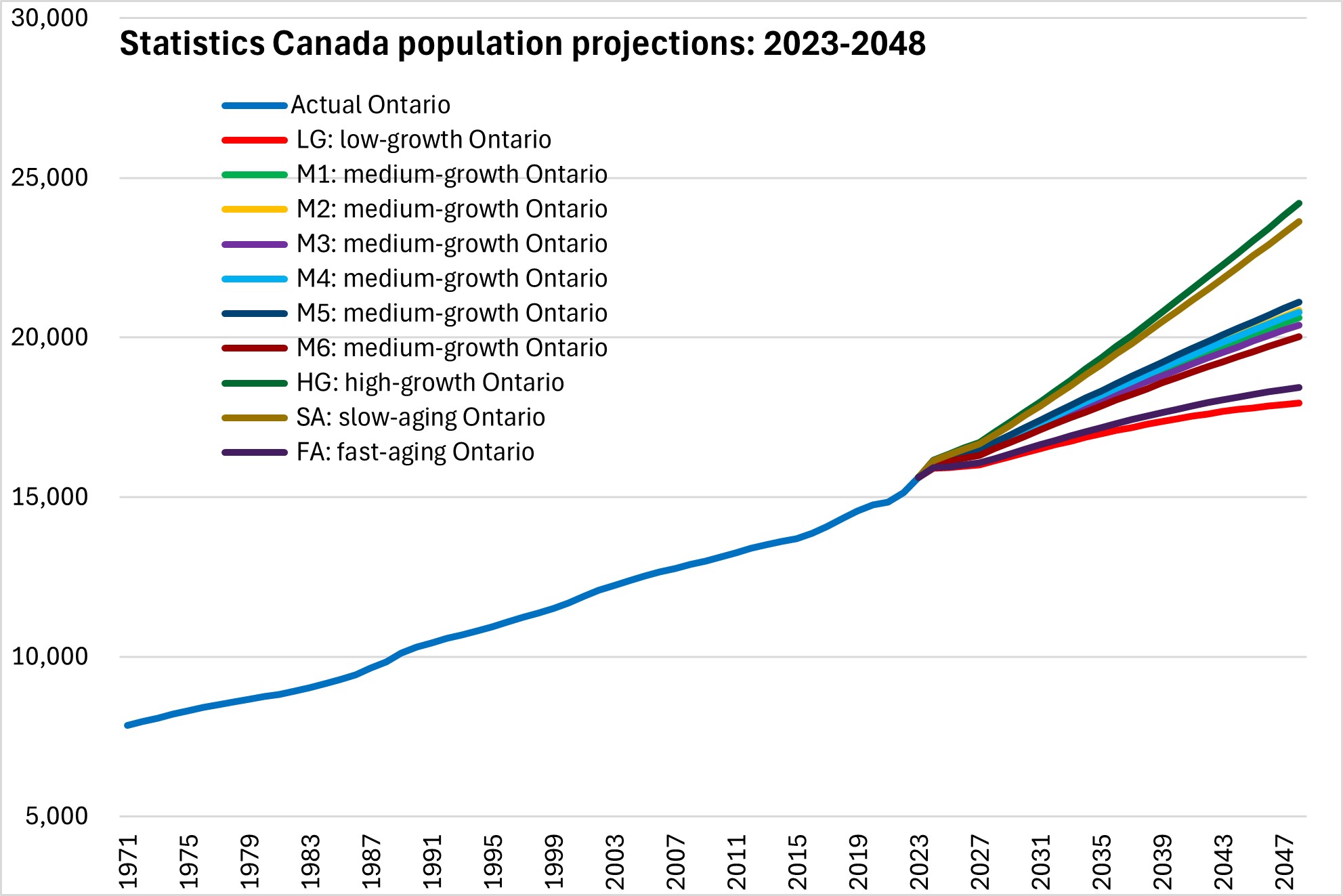
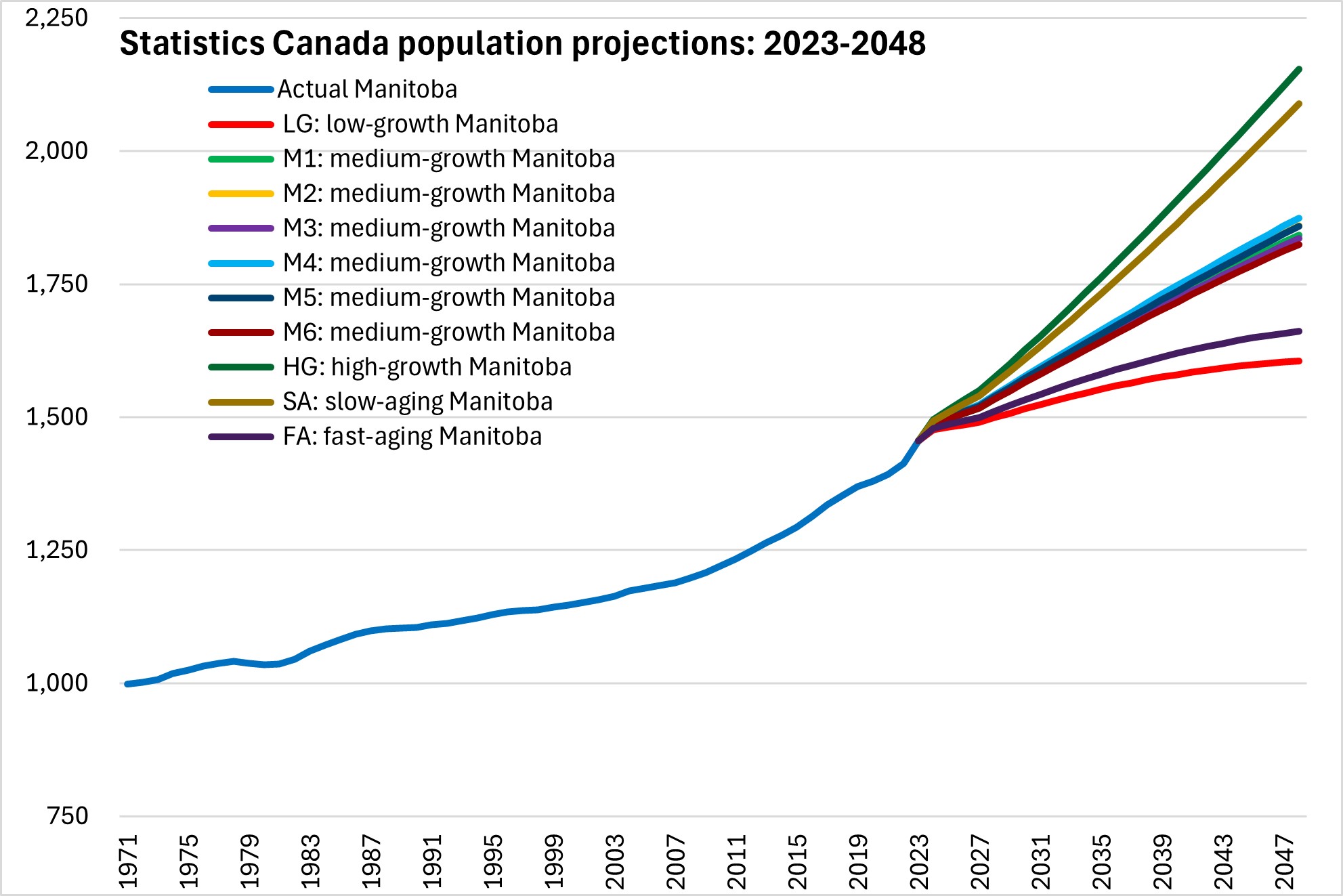
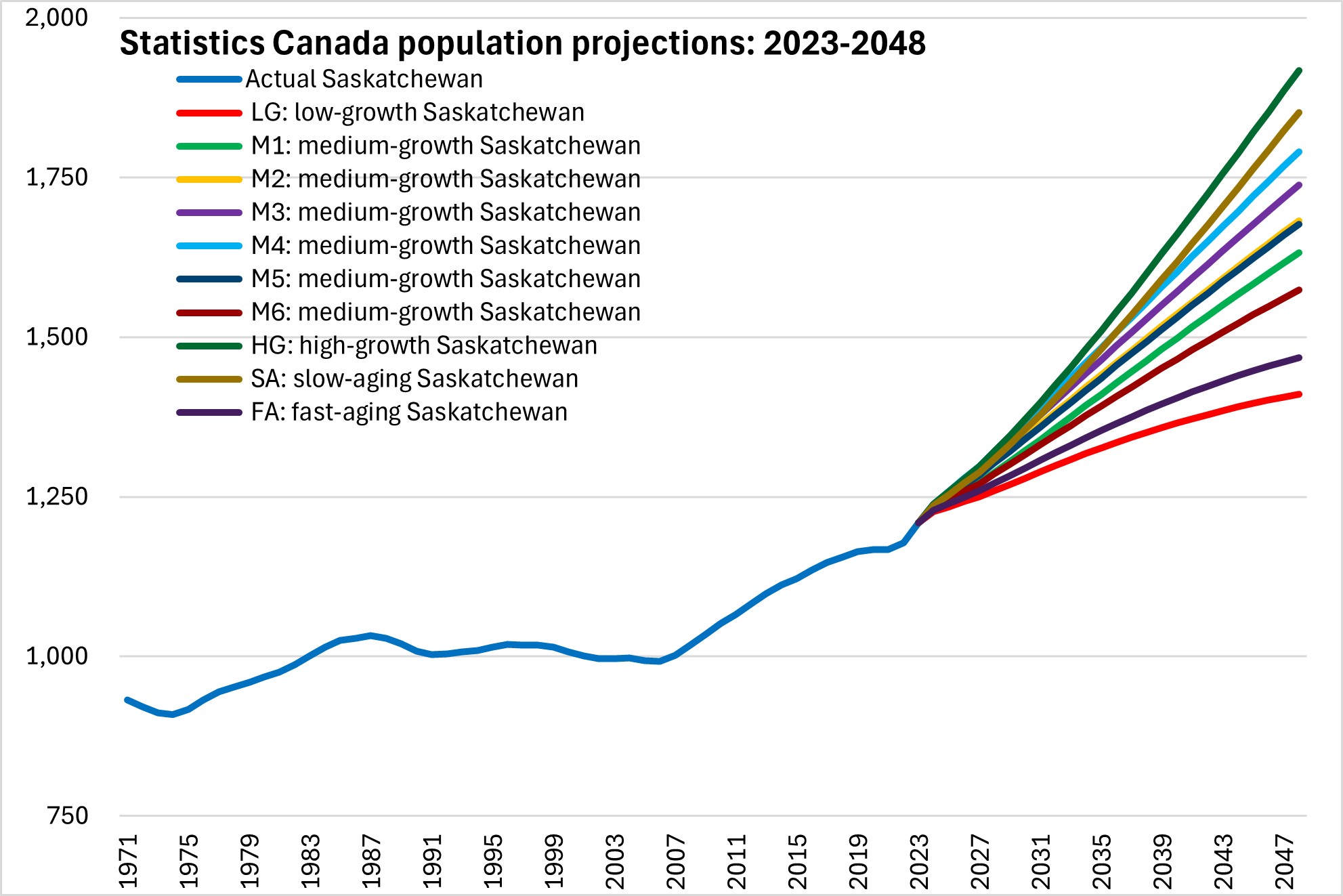
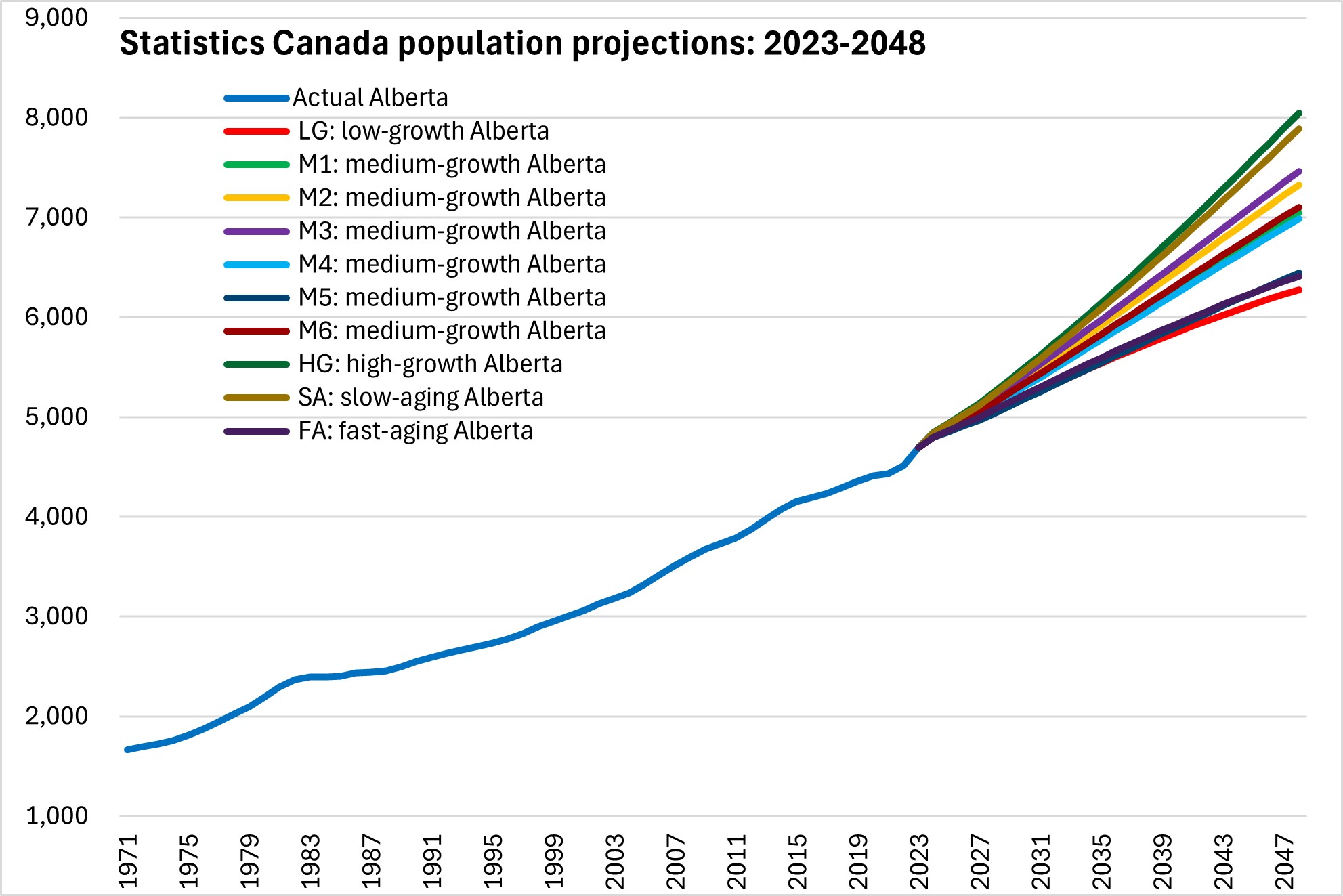
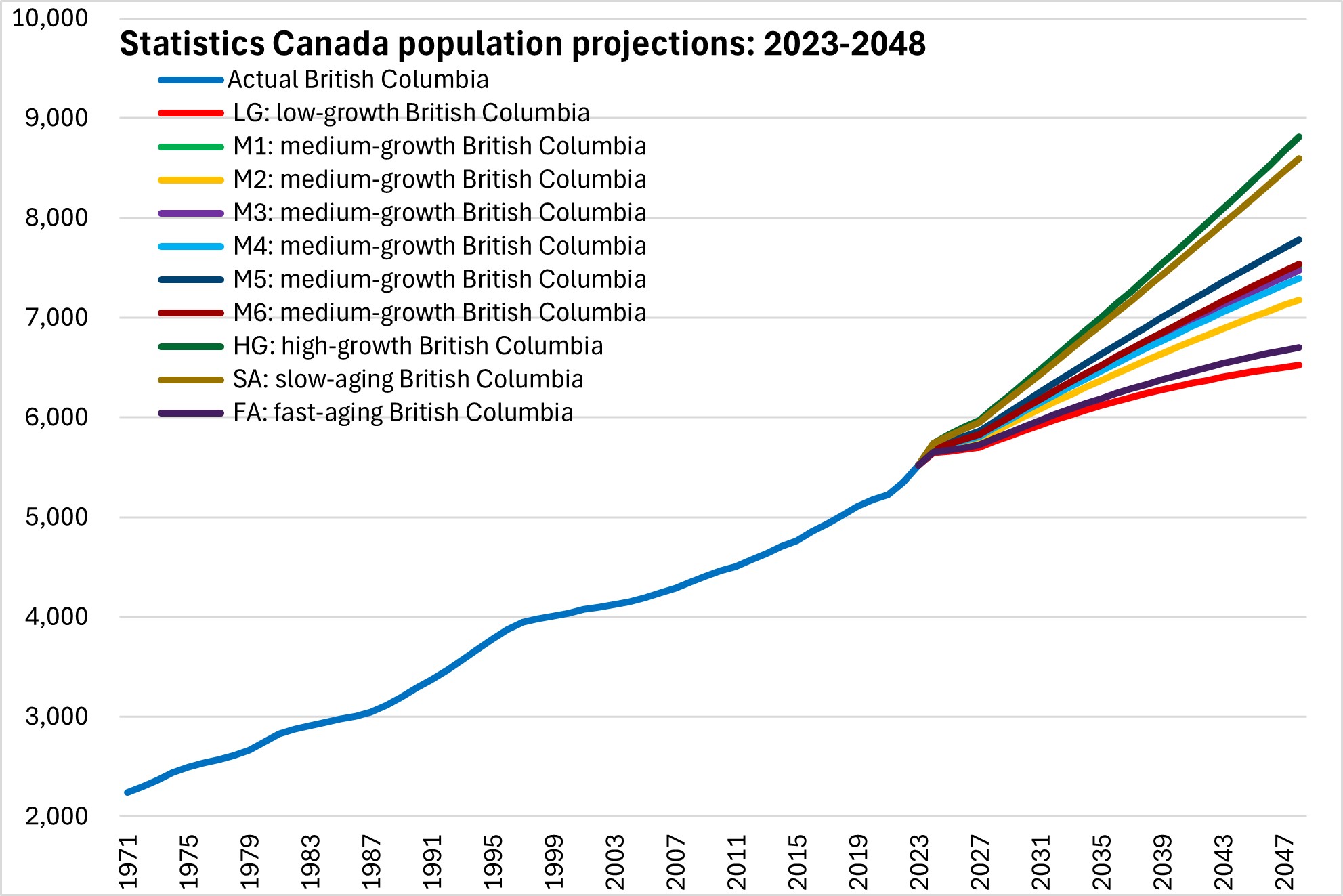
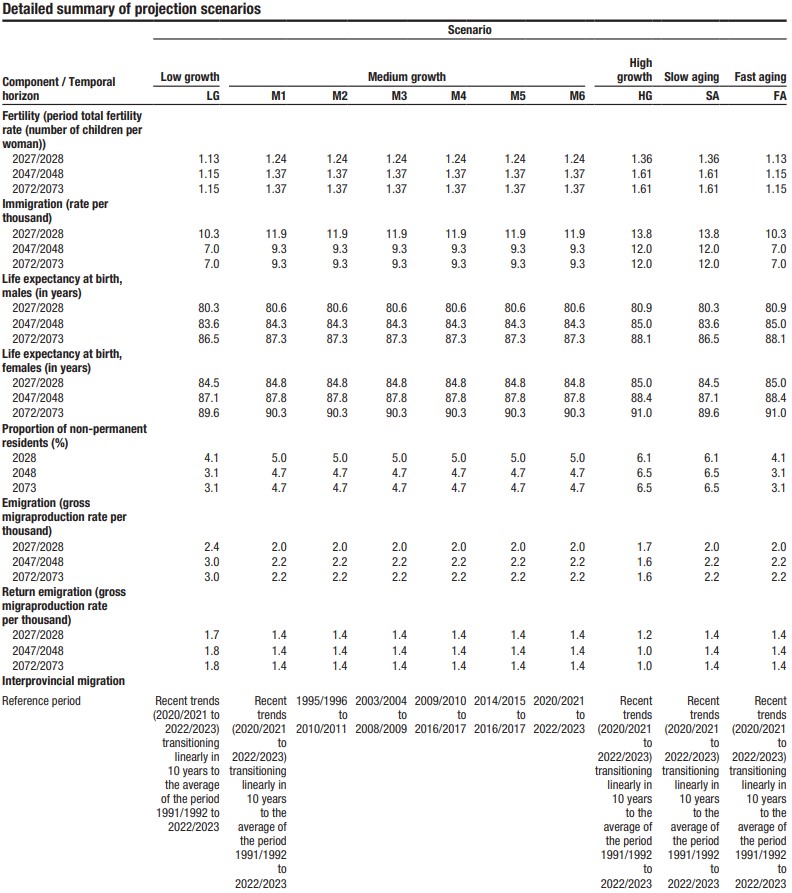
Sources: Statistics Canada. Table 17-10-0057-01 Projected population, by projection scenario, age and gender, as of July 1 (x 1,000); Table 17-10-0058-01 Components of projected population growth, by projection scenario (x 1,000); Table 17-10-0005-01 Population estimates on July 1, by age and gender; Table 17-10-0014-01 Estimates of the components of international migration, by age and gender, annual; Table 17-10-0015-01 Estimates of the components of interprovincial migration, by age and gender, annual; Table 17-10-0006-01 Estimates of deaths, by age and gender, annual; Table 17-10-0016-01 Estimates of births, by gender, annual; Population Projections for Canada (2023 to 2073), Provinces and Territories (2023 to 2048): Technical Report on Methodology and Assumptions
<--- Return to Archive